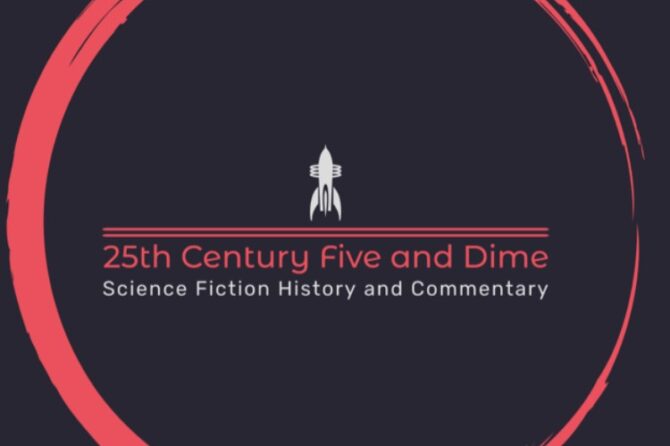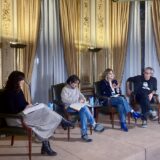
A sound artist mulls over how one of his artistic creations may be used to kill a sentient computer. Is this art, or a method of killing? How is it useful to the general public? And how does the artist feel about his art being used to kill?
As an interdisciplinary sound artist, Robert had done well in his twenty-year career to avoid becoming too self-critical of his own work until a man from Bell Labs in a dark suit with rounded sunglasses approached him at the Bixby Drew exhibition hall in Santa Fe, New Mexico, and asked if he could use Robotic Resonance Oscillator #229 to convince a sentient computer to kill itself.
“The sound of your machine is what we need,” he said. “It will send the universe’s greatest intelligence into an insanity so total, it will want to snuff itself out.”
A laugh escaped Robert. But as the man elaborated on the explanation with a deference towards not hurting his feelings, there was a worrying suspicion that it had not been a joke, and as the reasoning grew more elaborate, the facts coalesced into coded language like, “Your resonance barrier is an unrepeatable vector, which makes it a potentially lethal weapon against Agatha.” And from that language, a picture began to form – a picture of an obsessive, neurotic bureaucracy in the U.S. government, hellbent on fighting a sentient artificial intelligent computer named Agatha.
Robert’s mother was named Agatha, who was named after her aunt, and both of them had been dead for some time. It was a name that faded in popularity for decades, and must have been making a triumphant comeback if a computer could be named Agatha. He held onto this thought while trying to read deeper into what the man was telling him. How did he hear about the installation? Most of the reviews were negative. Some were even overtly hostile. The publicity was meager. It only attracted local artists and critics that kept Robert at arm’s length ever since he joined the Santa Fe college as an associate professor of sound design.
He noticed visitors of the exhibition had their attention turned towards him now, and as it happened to be a Friday, which was the third busiest day of the week for the gallery, he asked Mr. Sunglasses if he wouldn’t mind moving the conversation to somewhere more private.
He brought him downstairs to a modest workroom on the first floor where he had been building a new installation called, Orifice and Artifice. The room had been given to him as part of a residency which he was grateful to win, a real feather in the cap of his career, but the loneliness of the work, coupled with the solitude of the first floor, made progress difficult. It was too dark down there, since the first floor was technically the basement of a three-story building. It had once served as a manufacturing plant for vehicles before it was bought out and refurbished into an art gallery and co-working space, which meant that the old vestigial tracks and steel cages of the car plant still lingered, and no amount of filtration seemed to mask the acrid metallic odor which Sunglasses pointed out as they made their way into the room.
RRO229, as it was called in the gallery brochure, had taken Robert one full year to finish. It was partly finished here, but most of the work had been done in his girlfriend’s garage. Small little adjustments, like repairs and installations of minor pieces, including mechanical bearings, were fine-tuned before it was put on display less than four weeks ago.
He slid a wooden dole under the door to prop it open as they entered the work room. There was a putrid humidity in the air, a strange new stink he suspected might have been coming from a nearby water treatment plant. He switched on a small fan, then took his seat on the cold metal work bench beside his new installation, and smiled at Sunglasses with the assurance he was not at all offended by this new alternate reality that was suddenly developing for him.
“As I said earlier,” Sunglasses resumed, “There’s a lot of hard data to back this up.”
“Just so that I understand.”
“Yes.”
“My art is that terrible?”
He laughed.
“Your art has high utility. And we’ll pay you handsomely to use it. All expenses are covered on our end. All you have to do is sign this little paper I have here in my coat pocket that says you’ll give us permission to use the machine however we like.”
The we was Bell Labs. Robert had heard of them. But he thought they were just a phone company that became a cell phone company. Somehow, they also became a defense contractor for the United States government.
“There’s only one way to use my machine, though. Because it only does one thing, which is make the sound you’re talking about.”
“Yes.”
“How much are you paying me?”
He told Robert the number.
It was a lot.
“So what do you say?”
Robert said, “Okay.”
He wasn’t immune to an early retirement. He would never have to apply to another residency. He could finally buy a home for himself. Maybe convert a garage into a studio, and work out of there for the rest of his life, even as a hobby, and build more resonance machines. His critics would have labelled him a sell-out, but who cared what the critics said anyway. He wouldn’t be a sell-out, he would be a hero. A legend! Robert Salzman, the man of the 21st century!
“So what do you say?”
Robert said, “I guess you guys at Bell Labs are in a hurry to get this done.”
“We sure are.”
Sunglasses removed a long letter-sized white envelope from his coat’s breast pocket. He uncreased it, and handed it to Robert, who opened it to find a check written out for the exact amount he had been told it would, which was inside of a contract two double sided pages long with a space at the end for his signature.
“Is it okay if I read it first?”
“Please, Robert, take all the time you need.”
It was a good thing the contract was fairly easy to follow. These were the kinds of terms and conditions he had seen in other contracts before. The only part that disappointed him was the non-disclosure clause that kept him from promoting this.
“I hope you’re okay with that,” Sunglasses said. “We are offering a generous stipend for this work, of course.”
Robert was being paid for his silence. But he couldn’t see the point of keeping it a secret. Wasn’t fighting a sentient A.I. going to make enormous news?
“It only makes the news if we win,” Sunglasses clarified. “Losing is a much different scenario to paint for you. I don’t know if you’d want me to. But let’s just say: no one would be reading the news, anyway. So there’s only one scenario where the NDA you’re about to sign even matters. And it’s the scenario we’d all want.”
Robert always thought he was a simple man, and that his art, by contrast, was needlessly more complicated to compensate for that fact. So when he signed that contract, he felt it was making a promise to his art. That it would live on; that if it would be used as a weapon to save all mankind, at least there would be two artistic epochs: before Robert Salzman’s Robotic Resonance Oscillator #229, and after Robert Salzman’s Robotic Resonance Oscillator #229.
While they talked in his work room, upstairs on the second floor of the art exhibit a modest crowd gathered around RRO229, to listen to what Art Digest Weekly Issue Number 2943 had called, “The equivalent of having your brain gently rocked to sleep by a Boeing aircraft engine.” Two robotic arms repurposed from an automated palletizer were suspended over a harpsichord laid flat on a horizontal plane, and every two minutes they plucked strings with variable strengths. How hard they plucked, for how long, and exactly what frequency, were fully automated by software which ran off a low-voltage battery supply. Robert couldn’t take credit for the computer software; he couldn’t take credit for the harpsichord which belonged to his late mother; he couldn’t take credit for the robotic arms which he just bought out of an engineering catalogue; nor could he take credit for the sound they produced when the arms plucked the chords. The only element Robert could take credit for was pulling all of these disparate elements together, unifying alien artifacts into one room, welding them, sanding them until the beads were smooth, then painting over it with a copper alloy.
In a Sunday New York Times interview, Robert was quoted as saying that he always “fantasized about the kind of music a robot might someday make, if it was just given the means to play an instrument.” It needed two robotic arms. He tried four, but it looked more like a spider and the sound put him off, so he went back to two. He programmed basic conditions to tell the arms to play a few tones. It wasn’t anything complex. He just wanted to induce a hypnogogic state in the listener. An ambient journey into a robotic soundscape. What the sound did to machines, however, was the more pressing question.
“I know your machine isn’t entirely harmless to human ears,” Sunglasses said. “I’ve read about it in various newspapers, magazines, and underground art essays; how your machine leaves everyone feeling, and forgive me if I misquote this, “Ill and disconcerted about going on living.'”
He wasn’t mistaken about those accusations. Robert didn’t take umbrage with the publicity. He was used to it. But the hope was fading that there was someone else on the planet besides himself who actually enjoyed the sound the installation produced. He wanted to build three more just like it, but instead of harpsichords, he wanted to try out other instruments. Maybe an old electric guitar, for instance.
Sunglasses wasn’t very interested in his other projects. Every time Robert deviated the conversation to try and talk about them, he was brushed off. Bell Labs only needed this one exact installation.
“How will it be used, exactly?” Robert asked.
Sunglasses took back the letter he signed and hid it in his coat pocket.
“We’re going to trojan horse this installation as a gift to Agatha. Once it starts, it should have the intended effect. Bell Labs had competing intelligences working it out, parrying against Agatha, considering her every countermove. They never agreed on anything until exactly yesterday afternoon at 5:03 pm, Pacific Standard Time. They all said that Robert Salzman’s Robotic Resonance Oscillator #229 was the only machine on the planet capable of harmonizing a frequency that would disarm the central nervous system of the A.I. and shut down its self-defenses. Its only respite would be to virtually hurl itself off the tallest building it could find, digitally speaking of course, and plummet to a death so that it would never have to endure your abominable machine ever again.”
Robert rifled his fingers through his hair.
“I actually tried to find you last night,” Sunglasses said. “After the results came in, I booked a flight out of our St. Louis bureau. Landed in Santa Fe airport on a hypersonic jet at 7:14pm. Drove to your apartment complex. Tried your door. Your plant needs water, by the way. Then I sat in the car to see if you would show up. Around 3 in the morning, I phoned in to my superiors to let them know you were MIA. On their counsel, I drove to two places, Sundowner Saloon-”
“How did they know about that?”
“-and when you weren’t there, I drove straight here, but the security wouldn’t let me in until they opened…”
“Sometimes, I work into the night here,” Robert answered. “I have a little inflatable in the corner that I bought. It’s just easier for me. I don’t like to drive when I’m tired. And so you know I don’t visit the Sundowner very often anymore, I’ve cut back on the boozing.”
“It’s fine, Mr. Salzman, there’s no judgment from me. Artists are an eccentric bunch, aren’t they? I’m just relieved I was able to find you.”
“My art only kills machines,” Robert said.
Sunglasses pondered the statement.
“What do you mean?”
“I mean, nobody’s ever died of it. Yes, some people feel sick. Some people get anxious or feel malcontented after a few minutes. But nobody’s ever gone back home to blow their brains out. I just want to make that clear. So you don’t have the wrong idea about my art.”
“We have classified intel on your artwork. It was sufficient to tell us if this would work.”
“Classified?”
“Classified.”
“Does that mean there’s something more you know that I don’t about my own art?”
“Mr. Salzman, I think you’re looking at the hole when you should be looking at the donut. What you’ve done is make a work of real utility in the world. Whatever opinions people might have, it’s entirely irrelevant to the bigger point here. We are on the precipice of changing the world for the better.”
Robert liked what he was hearing.
“Did you hear it yet?” he asked Sunglasses.
“No.”
“Would you like to?”
“I’m only here for your signature, Mr. Salzman. I’ll phone my superiors, and we’ll start the logistics of shipping out your machine to the Air Force base in San Diego.”
“Maybe you’d like to come upstairs, have a listen first.”
“It won’t change my opinion on your art, one way or the other.”
“That’s not what I’m interested in. You’ve come all the way here. Why not go up to the exhibit with me? Experience it for yourself?”
Robert sensed his hesitation.
“Let me call in to my superiors before I do.”
“What are you so afraid of?”
Sunglasses smiled. Maybe he wasn’t used to being given orders, but doing the ordering himself, which is what threw him off. Then, he removed his sunglasses, as if he were lowering a shield of some kind to see Robert on a more intimate level. He had business eyes – piercing, intense, green, the color of money. There was something in it for him, too, wasn’t there? Something that went beyond winning a war with Agatha.
“I’ll listen,” he finally said. “But not for more than two cycles.”
Sunglasses followed him down the hall to the emergency stairwell reserved for employees. They took it to the second floor of the exhibition hall, technically the ground floor, where the ceiling opened in a dramatically satisfying reveal of an expansive terrarium-like enclosure with high stained glass windows, angled in varied directions to skew the light and create dazzling refractions as the sun passed overhead. Robert’s sculpture occupied a ten by ten meter space near the center of the room. Its robotic arms were stiffly held above the harpsichord on two parallel tracks in a motionless anticipatory silence.
A crowd stood waiting for the next cycle which gave Robert time to guide Sunglasses to where he could see the machine operate.
“I programmed the silence as a palate cleanser,” he explained. “Silence is also a polite way out, don’t you think?”
“I suppose it is,” he replied. “But nobody ever offended a machine.”
“Except for me, right?”
He smiled. “I would say offense would be putting it a touch too mildly.”
“It’s offended people, that’s okay. You’ll be shocked if anyone here stays for the second cycle. One of my reviews said, ‘It’s just a filthy, ugly sound. And a filthy, ugly device. It’s not pleasing to listen to, and it’s even less pleasing to look at. It leaves me gratified that the scope of the work was not more ambitious in trying to reach the other senses like touch or smell.‘”
“How did that make you feel?”
“Like I wished I never made it. I’ve read it countless times and burned that passage to memory.”
“I admire you, Mr. Salzman. It takes a brash, hard-nosed kind of constitution to read a review like that and not let it eat you away.”
“It absolutely eats you away,” Robert replied soberly. “Over time, it eats you less, but there are days I dwell on the words. Days I regret making anything. Like my life is just one big creative anomaly. Critics say I throw it together over a weekend, like a side project to my real work. This wasn’t a side project; it was a full-time job; all of my attention was on this one thing. I had nights, lying in bed unable to sleep, when a sudden idea would rouse me, something really exciting, and I’d spring into action like a rabbit darting out of its little burrowed hole – do rabbits burrow? – anyway, like a rabbit dashing across the sunlight, the idea grabbed me, you know, and I couldn’t wait to get into the studio to keep working…”
“That’s why your plant died.”
“Huh?”
“The plant, by the door outside your apartment, I mean.”
“Oh. The gardenia. That was a gift from a friend. They haven’t come by to see me in awhile, so they don’t know I haven’t been taking care of it. Anyway, I’ve neglected the plant just like I’ve neglected that friendship. Everything wilts when my attention is too focused on this one thing to the exclusion of everything else. But critics don’t see that sacrifice. They only see the machine in its final form, as if the story of its creation begins and ends in the art exhibit and not in some garage, where it’s laying on the cement floor in a bunch of pieces and it’s up to me to assemble it all.”
The robot arms came to life, and sent the crowd into a hush. Their metallic fingers lowered down to the strings of the harpsichord and began to pluck, but it wasn’t a bright sound; instead it was a dead, dull tone, as though the instrument was badly de-tuned or damaged.
A few people turned away. Some brought their hands to their ears. But Robert was most interested in what Sunglasses would do. And so far, his reaction was stoic. He stood there, unmoving, just watching the hands of the robot as they plucked, then traveled on a conveyer overhead, to play another part of the instrument.
When the cycle ended, everyone shuffled off. Robert turned to his guest, curiously.
“Are you staying for the second cycle?”
“I told you I would, Mr. Salzman.”
“It wasn’t that bad, right?”
Sunglasses had to think about his answer.
“To be completely honest with you, this isn’t my area of expertise,” he answered. “I don’t think my feedback would be helpful.”
“You can tell me what you think of it, it’s okay. I won’t be hurt.”
“The sound reminds me of a golden spoon my mother used to keep in the drawer. It was a souvenir from some vacation. Milan, maybe? When the spoon struck a piece of ceramic, it would produce a sound like what your machine is making. Except it wasn’t as sustained. It was very brief. I liked to play with it. The harder you hit the spoon against the plate, the higher it would pitch the sound. If you hit it hard enough, you could even see the spoon vibrate. I played with it so often, she took it away from me and hid it in a little box with a few other miscellaneous mementos. Listening to this, it brought me back to the spoon, and the box, and my mother. It made me think of what the spoon meant to her, and why she kept it for as long as she did. To be completely honest, this whole time, it’s all I’ve been thinking about. Once the sound started, my mind just wandered. I was hardly paying any attention at all to anything outside of that thought. I’m sorry. It’s why I don’t think I can be a very valuable sounding board for you.”
“Maybe on the next cycle.”
They stood in the room like passengers on a platform waiting for a train. Around them were footsteps, low murmurs and muffled coughs. Robert thought how great it was that there would always be more people to hear it for the first time. That the world was providing an almost inexhaustible supply of ears for this performance, and even if they wandered away without any further interest, new ears were on the way.
The arms activated again, which was met with a vocal surprise from visitors. As the fingers came down on the chords for the second time in fifteen minutes, the room was once again plunged into an aurally fixated point in space, a dull roar that called upon memories of spoons, and wooden boxes and dead mothers, and battered, fragile thoughts, dreamlike and pixelated, combining only to break apart again, born into life and then dying all within a span of seconds or milliseconds. If a point particle traveled at the speed of light to journey its way from one neural link in the brain to another, connecting two memories of cardinal spacetime, and then continued on traveling after that, then the memories and textures conjured were untenable, and couldn’t be depended on. They were just a magic show, ethereal like the wind, blowing through people’s brains like a cool draft in a hallway full of forgotten opened doors and windows. For some listeners, like Sunglasses, the droning put them in one place, attaching lead weights to their thoughts so they weren’t free to roam so easily. Robert saw his guest’s face start to contort with unease, as if his thoughts wanted to roam but the sound wouldn’t allow it.
What would Agatha think when it heard this sound, noodling around in its digital synapses? Did Robert invent a way to lock it in a trapped memory with no way out and swallow the key? A room with no way out must always be built from the outside in. Perhaps that is how the AI would find its last moments – in a room that closes in, until it’s unable to move within it, and the only remaining maneuver is to push every corner and wall towards the other to create a single, solitary burdened point in space, as crushingly dense and infinite as a black hole in the center of the universe.
My art only kills machines, Robert assured himself. It only kills machines.
END










